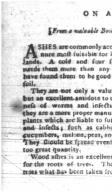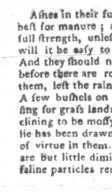[ On Ashes for Manure ] Samuel Deane
Date: 1791/02/04
Source:
Nova Scotia Magazine
Institution: Nova Scotia Archives
| Source Origin: Nova Scotia Newspapers on Microfilm
| Reference: Microfilm Reels 8062, 8063
Instructions for using ashes as a fertilizer and as a pesticide in cabbages, turnips, cucumbers, melons, peas, pulses, trees, and "Indian corn." nn.98_99. Microfilm Reel 8063.
ON ASHES FOR MANURE.
[From a valuable Book lately published, entitled The New England Farmer.]
ASHES are commonly accounted a ma-
nure most suitable for low and moist
lands. A cold and sour spot certainly
needs them more than any other. But I
have found them to be good in all sorts of
soil.
They are not only a valuable manure,
but an excellent antidote to the rapacious-
ness of worms and insects. Therefore
they are a more proper manure for all those
plants which are liable to suffer by worms
and insects; such as cabbages, turnips,
cucumbers, melons, peas, and other pulse.
They should be spread evenly, and not in
too great quantity.
Wood ashes is an excellent nourishment
for the roots of trees. They restore to
trees what has been taken from trees; and
__
tend at the same time to drive away cer-
tain insects which are hurtful to trees.
Ashes of all kinds are a good ingredient
in composts which are under cover. But
when they are laid upon land unmixed,
they should be laid as evenly as possible.
They are thought to do better on the top
of the surface than buried in the soil; for
there is nothing in them that will evapo-
rate. Their tendency is only downwards;
and their salts will soon sink too low, if
they be put under the surface. If they
be spread upon the ground which has ten-
der plants, it should be done just before a
rain, which will dissolve and soften their
acrimony: For tender plants, when the
weather is dry, will be apt to be injured
by them.
[page break]
Ashes in their full strength are certainly
best for manure; and they will not be in
full strength, unless they be kept dry; nor
will it be easy to spread them properly.
And they should not be laid on lands long
before there are roots to be nourished by
them, lest the rain rob them of their salts.
A few bushels on an acre are a good dres-
sing for grass lands that are low, and in-
clining to be mossy. But ashes from which
lie has been drawn have no small degree
of virtue in them. The earthly particles
are but little diminished; and some of the
saline particles remain.
A handful of ashes, laid about the roots
of Indian corn, is good to quicken its
vegetation. But it should not much of it
be in contact with the stalks. The best
time for giving corn this dressing, is
thought to be just before the second or
third hoeing: But some do it before the
first, and even before the plants are up.
Like other top dressings, it is of most ser-
vice when applied at the time when plants
need the greatest quantity of nourishment.
This happens in Indian Corn when the
plants are just going to send out ears and
spindles.
Download: Transcription | Images

